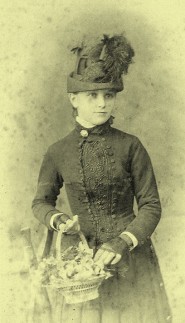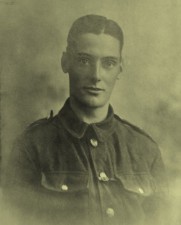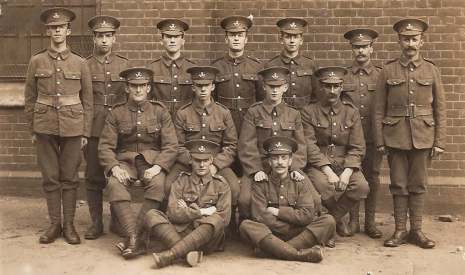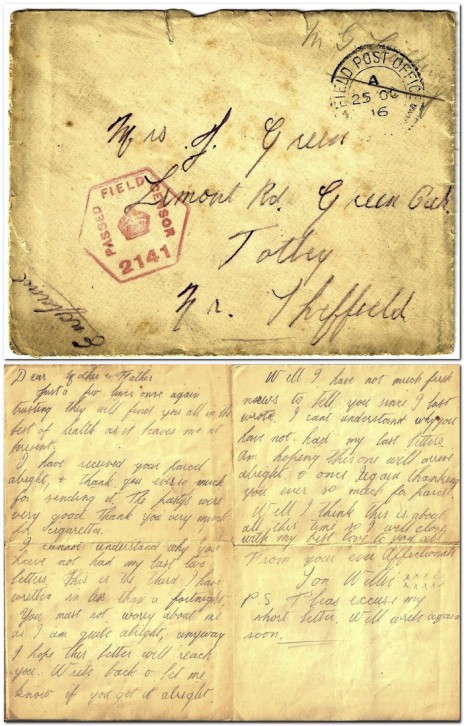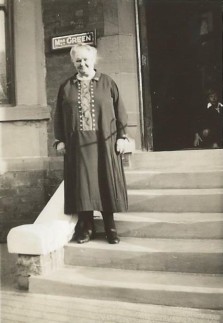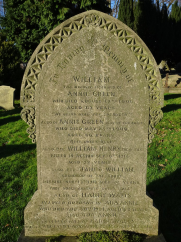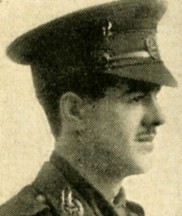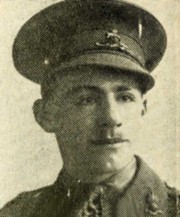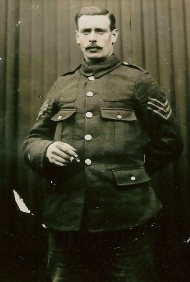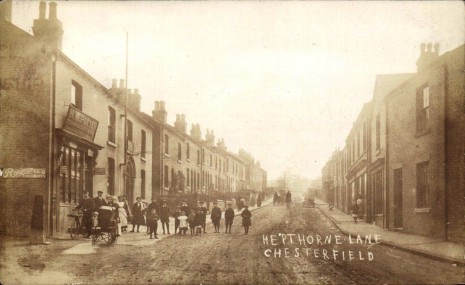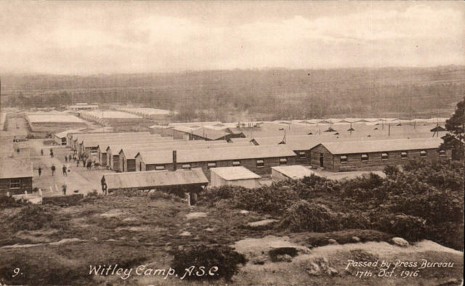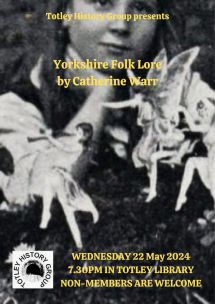WW1 Casualties F-K
Tom Brown Fisher
Tom Brown Fisher was born on 10 October 1893 at Hallfield Farm, on Strawberry Lee Lane, Totley. He was the youngest child of Francis and Emma Fisher (nee Hill). He had two brothers, Frank and George, and three sisters, Mary, Annie and Jane (Jessie).
Tom's grandfather, Thomas Fisher, came to Totley from Brampton around 1836 and became the publican and farmer at The Cross Scythes before moving to Hallfield Farm where he lived from about 1843 until his death in 1885. Francis Fisher, Tom's father, inherited the farm but he died in 1895 at the age of 57.
By 1901 Hallfield Farm was being run by Eliza Fisher, the widow of Francis's elder brother John and Tom was living in a cottage at Lane Head, Totley with his sister Jessie and mother Emma who was supporting them by working as a charwoman. Tom was enrolled at Totley All Saints School in March 1898 when he was 4 1/2 years old. In August 1907 he left school to begin work on a local farm.
He was fondly remembered by local man Archie Thomas (1903-1991) who wrote: “In the bottom cottage in the 3 on Baslow Road lived Mrs Fisher. To my brother and I there was no-one like her in the world, she had 3 sons at home and the youngest daughter Jess; 3 other daughters being out in service. Jess later became Mrs Joshua Tyzack - an affair of which I probably have more knowledge than any other living person! I loved the youngest son, Tom, and one of my earliest recollections of him (when I was about 3 years old) is of him taking me by the hand one dark winter’s evening and going to Ash Cottage where he milked a couple of cows for an elderly Mr and Mrs Hattersley.. When he took the milk to the house he was given about a half-gallon can of morning milk for his mother. I used to go with him when he was mowing and sit on his knees on the machine for hours at a time, while he mowed the land where Main Avenue, Rowan Tree Dell and all that property now stands.”
This mowing machine would have been horse-drawn at this period, of course. By the time of the 1911 census, Tom had moved out to Beeley where he was working as a cowman at Moor Farm.
Tom Fisher's Army Service Record was among the 60% destroyed during the Blitz in WW2 so it is not known when he originally joined the army. When he enlisted in the Derbyshire Yeomanry in Totley his residence was given as Holmsfield so it would seem that he had moved back to work in the local area by the early years of WW1.
At some point he was transferred to the 6th Dragoons (Inniskilling) and on 1 December 1917 he took part in the cavalry charge south of Villers Guislain. The Dragoons were cut down by heavy machine-gun fire and shrapnel and 169 of them died along with 271 horses. Tom Fisher was among those who died. His body was never found but he is remembered on Panel 1 of the Cambrai Memorial at Louverval.
James William Green
James William Green (known as Willie) was the first child of James and Mary Alice Green who married in Christ Church, Dore in 1895. His paternal grandfather, another James, was a joiner and wheelwright working well into his seventies from his home in Chapel Walk (now called Chapel Lane).
He also owned a grocer's shop at the corner of Summer Lane, his wife Millicent being recorded as a grocer in 1861. The shop was photographed around 1906 where Willie's brother and sister appear with the shop manager. The owner can be seen to be James Green, Willie's father, his grandfather having died in 1901. Willie's father was a mechanical engineer and for a short time after his marriage lived in Norton Woodseats where Willie was born on 17 December 1895.
By 1901 the family were back in Totley living in Grange Terrace, perhaps among the first to occupy one of these houses built at the end of the 19th century. His mother, Mary Alice, also had the surname Green prior to her marriage to James Green. Their common ancestry appears to be in the early 19th century, making them second or third cousins. Mary Alice was a 17 year old kitchen maid at Totley Hall in 1891.
There still exist a number of studio portraits taken throughout her life. The one shown here was taken in 1887 when she was 14 years old and is reproduced in Totley District in Old Photographs by Brian Edwards.
She is remembered by her grand-daughter who recounts her talk of ailing horses being grazed on the bank below the Wesleyan Chapel where fine herbs in the grass helped their recovery. She had the sadness of losing another son who died in infancy when he drowned in the dolly tub.
Willie was admitted to Totley All Saints School in 1900, leaving to attend another school in November 1906. This is slightly unusual as the children of the village stayed at the school until the age of thirteen when they left to start work.
However it is quite possible that he moved to Dronfield Woodhouse Council School at the top of Mickley Lane, now in use as a nursing home. Extracts from the Committee Meeting Minutes, the only surviving document of the period, show that it won praise from inspectors for its standard of teaching, and that each year a small number of children won scholarships to Henry Fanshawe Grammar School.
In 1908 it recorded that there were 180 pupils and that 14 were from Totley Parish, which indicates it was not impossible that Willie would be there, then aged 12. His family remained in the village and his siblings in Totley All Saints School. In the 1911 census Willie had left school and was recorded as a joiner.
Willie enlisted in the Oxfordshire and Buckinghamshire Light Infantry on 29 June 1915 as Service No. 18960 Pte James William Green, attesting at Chesterfield. He was allocated to the 2nd Battalion of the Regiment.
The 2nd Battalion were in France at the time, having been there since August 1914. They were stationed around Bethune and in August 1915 took over trenches near Givenchy about five miles out of town. The soldiers usually spent about four days in the trenches before being relieved and replaced for a few days rest, then back again. The Battalions received replacement men constantly as they suffered casualties - 40 men were received on 26 August, 85 men on 5 September, 25 men on 15 September, 16 men on 20 September. Willie will have spent a number of weeks training before being sent to join the Battalion, so it may well have been September or October before he reached the front.
Almost certainly Willie would have been part of the Battalion by November 1915. November was wet and trenches had to be repaired as they fell in. Things were reasonably quiet except for occasional shelling and sniping. It remained that way throughout the spring of 1916 and time was spent training, keeping trenches in good condition, and even playing football matches.
In July the 'real war' exploded with the Battle of the Somme and extracts from Major R M Owen's diary reveal the events leading up to Willie's death:
July 20th. The Regiment paraded at 9.20 a.m. and entrained at Pernes Station at 10.50 a.m.; arrived at Saleux, a little south of Amiens, at 4.35 p.m. Detrained, and had a long march (16 miles), not arriving at Corbie until after midnight. The men marched very well, only two falling out.
July 23rd. The Regiment marched at 10.30 a.m. to “Happy Valley”, [at the front] and arrived at 4.30 p.m. Enormous number of horses and vehicles here, all standing in the open. Bivouacked.
The following days were spent preparing for an attack to take Guillemont, the 2nd Ox and Bucks being responsible for taking and holding the railway station.
On July 29th the 5th Infantry Brigade issued orders for the attack, including these communications instructions:
Pigeons. There are 4 birds at Waterlot Farm and 4 at Bernafay Quick communication can be obtained at any time by this means. Birds fly to Corbie, and wires are sent back through 2nd Division. Total time taken, about 30 to 45 minutes to Brigade H.Q. It has been noticed that both pigeons and pigeon-flyers have been left, without a scrap of cover, sitting outside Battalion H.Q Both should be given a corner of a dugout.
The Brigade also issued instructions to soldiers:
All troops taking part in the attack were ordered to carry 2 bandoliers and 3 grenades per man, in addition to the necessary picks and shovels, while “all companies going over the top” were to have water-bottles filled and one day's ration per man, in addition to iron ration.
July 30th. The push failed, and with many casualties being taken they withdrew.
August and September. Largely spent training with a short time in the trenches, although always taking casualties and having a constant need for more soldiers to replace those killed and wounded.
October. Much reconnoitring took place and eventually Willie was moved to a billet in Mailly Maillet.
October 25th. To trenches in Redan Section in relief of the 24th R. Fusiliers (left sub-sector) and 2nd H.L.I. (right sub-sector). As usual after a few days they were themselves relieved then returned on...
Nov 9th. The relief began up 6th Avenue about 4 p.m., and was effected without incident. The trenches were found to be, on account of the weather, in an appalling condition, in many places impassable, so that traffic was generally overland after dark.
About 9.20 p.m. Captain Peploe was very badly wounded by a sniper. He died a few minutes after being wounded while being brought in. Lieut. V. E. Fanning succeeded to the command of B Company.
Nov 13th. The day of Willie’s death. A number of Brigades were attempting to take and consolidate a part of the German Front Line known as “the Green Line” and it was during this attack that Willie was killed. The diary records “A Brief Narrative of Events”.
On at any rate the 5th Infantry Brigade front, the attack, which began at zero 5.45 a.m. by a short but heavy bombardment of the German Front Line System, came as a complete surprise to the enemy, and within the Green Line very little [if any] resistance was encountered.
Considerable inconvenience and some casualties were, however, caused by a party of about 40 Germans who remained for nearly 48 hours "unmopped up" in the German Front Line about the point to which it was intended to dig the Cat Street tunnel - possibly because they happened to be just at a point of junction between two attacking brigades, for which the troops of neither felt responsible.
The thick mist made keeping of direction very difficult.
Nov 19th. The long Battle of the Somme was halted due to bad weather. There were 420,000 British casualties during this action.
This letter is thought to be the last one received by his mother prior to his death. It says nothing of the dreadful conditions the soldiers were enduring as their correspondence was heavily censored. Neither does the envelope give any indication of where it was posted.
It reads as follows:
Dear Mother & Father
Just a few lines once again trusting they will find you all in the best of health as it leaves me at present.
I have received your parcel alright, & thank you ever so much for sending it. The pasty's were very good. Thank you very much for cigarettes.
I cannot understand why you have not had my last two letters. This is the
third I have written in less than a fortnight. You must not worry about me as I am quite alright, anyway I hope this letter will reach you. Write back & let me know if you got it alright.
Well I have not much fresh news to tell you since I last wrote. I can't understand why you have not had my last two letters. Am hoping this one will arrive alright & once again thanking you ever so much for parcel.
Well I think this is about all this time so I will close with my best love to you all.
From your ever affectionate Son Willie XXXXXX XXXXXX
PS Please excuse my short letter. Will write again soon.
Willie Green's body was never recovered but he is remembered on Pier and Face 10A and 10D of the Thiepval Memorial together with 72,000 other soldiers who shared the same fate.
In their later years, his parents lived on Mickley Lane, moving there when the houses were new. His father died in 1941, his mother in 1950 and both are buried at Christ Church, Dore.
John Green
John Green was born in 1893. He was one of two adopted sons of William Henry Green from Pitsmoor and his wife Ruth Sophia. She was the daughter of John Coates, a farmer and beerhouse keeper and his wife Harriett, nee Pinder who lived at Totley Bents. Who John's birth parents were and where he was born remain undiscovered. After their marriage at Sheffield Parish Church in 1890 William Henry and Ruth went to live at Mickley where he followed his father's occupation as file cutter.
They had moved to Totley Rise and were living with their two adopted sons in the 1901 Census. White's Trade Directory for 1905 shows that William Henry had become the licensed victualler at the Crown Inn. However, he was refused a renewal of his license in 1912 following an incident the previous May when he was found guilty of being drunk on his own premises.
John Green was apparently living in Barnsley in 1914 when he enlisted as a Private in the 1st Battalion of the Royal Munster Fusiliers. He had been with the British Expeditionary Force in the field for 16 months when he was wounded in the chest in late September 1916. He died from his wounds on 3 November 1916. He was 23. Private John Green is buried at the Bailleul Community Cemetery Extension, France, close to the Belgium border.
His parents later went to live in Blackpool where they ran a boarding house. John's father died in 1922 and his mother in 1941. John Green is commemorated on Blackpool War Memorial, near North Pier.
William Henry Green
William Henry Green, known as Willie, was born in Totley on 15 May 1880, the second son of William Green, a labourer, and his wife Annie, nee Mather who had married at Christ Church Dore on 3 August 1870. William was the son of Sampson Green, a saw grinder who lived on Totley Hall Lane. Ann was born in Dronfield, the daughter of John Mather, a carter, who had come to live at Bradway Mill by 1851.
At first the family lived in Bradway where Hannah Elizabeth was born in 1870 but soon after the family moved to Totley where eight more children were born in the space of twelve years: Sarah Jane (1872), Mary Alice (1873), Walter (1875), Emily (1877), Harriet (1878), Willie (1880), Ada Annie (1882) and George (1884).
Willie was educated at Totley Church School from the age of 6 but he disappears from our records after the 1891 Census when he emigrated to Canada. When war broke out he enlisted in the 4th Battalion of the Canadian Infantry (1st Central Ontario Regiment) which almost immediately sailed for England.
Willie was killed in action on 8 September 1916, aged 36. Private William Henry Green is buried at the Sunken Road Cemetery, Contalmaison, Somme, France and is remembered on his parent's gravestone in Dore churchyard. Also remembered on the gravestone is Willie's cousin James William Green who died in the Great War and who is one of the ten soldiers commemorated on Totley War Memorial.
Stanley Gummer
Stanley Gummer was born in Rotherham in 1890, the elder son of William Guest Gummer, a brass manufacturer, and his wife Gertrude (nee Hemingway). He was educated at The Leys School in Cambridge where he was a noted scholar and active sportsman.
On leaving school he became articled to a solicitor in Rotherham and completed a law degree at the University of London. He became a partner in the Rotherham firm of solicitors, Messrs. Gichard and Gummer. He was a good cricketer, playing for Rotherham Town and Yorkshire County Second XI and also a keen rugby player.
On 24 September 1913 when living at Brentwood, Brinkburn Vale Road, Stanley married Vera Gichard at Rotherham Church. The couple had two children, Dinah born in 1914 and Michael born in 1917 shortly before his father's death.
At the outbreak of war, Stanley Gummer enlisted in the 5th Battalion of the York and Lancaster Regiment and was quickly promoted through the ranks to Captain. He served with the Expeditionary Force in France and Flanders from 19 September 1915 until he was killed in action at Passchendaele on 9 October 1917 aged 27. He is remembered on Panels 125-128 of the Tyne Cot Memorial at the cemetery of the same name in Zonnebecke, Belgium.
Tom Kershaw Hall
Tom Hall was born in Stretford, Lancashire in 1897, the only child of Frank Hall, a mechanical engineer, and his wife Ada (nee Kershaw).
In the 1901 census the family were living in Shifnal, Shropshire with Tom's grandfather, Edwin Hall, but by 1911 they had moved to Totley Rise, living at Littlehaven, 85 Baslow Road. Later they moved to Ashleigh, 92 Totley Brook Road. Tom Hall was educated at Chesterfield Grammar School and at Sheffield University.
At the outbreak of the war he worked in the laboratories of John Brown and Company at their Atlas Works in Sheffield. In February 1915 Tom enlisted as gunner in the Royal Field Artillery, serving in the ranks until October 1915, when upon a special nomination of the university, he entered the Royal Military Academy at Woolwich. He was successful in the examinations, passing out third, and received his commission in August 1916.
Tom Hall arrived in France on 16 September and proceeded directly to the front where he saw much fighting. He was killed whilst carrying out his duties as a forwarding observing officer on the Passchaendale Ridge on 9 October 1917, aged 20. His commanding officer wrote "He was a keen and fearless officer and was killed when assisting men who had just been wounded." Second-Lieutenant Tom Kershaw Hall is commemorated on Panels 4-6 and 162 at the Tyne Cot Memorial, near Zonnebecke, Belgium.
Reginald Hartley
Reginald Hartley was born in Totley in 1892, the second of four sons of Tom Curtis Hartley and his wife Agnes, nee Livsey who married in Manchester in 1885. After taking a B.A. degree at London University, Tom became a schoolteacher and it was whilst living in Willesden that the couple's first son, Bernard, was born in 1887. Soon afterwards Tom took up the roles of assistant master and then headmaster at Hipper Street Board School, Chesterfield and came to live at Totley Brook Road. In July 1892 Tom was appointed assistant inspector of schools for Worcestershire and the family which now included young Reginald moved to Worcester in September 1892. Two more sons were born there, Sydney in 1894 and Norman Curtis in 1899.
Reginald was awarded a scholarship to Bromsgrove School where he distinguished himself as an athlete. He passed his matriculation for Oxford University in 1910 and gained his second class B.A. degree in August 1914 just before war broke out. He enlisted in the 10th Battalion of the Worcestershire Regiment and received his commission in December 1914.
Lieutenant Reginald Hartley became the first officer from that battalion to be wounded in action in September 1915. Worse was to follow when Reginald was killed in action at Festubert on 26 October 1915. Reports say that he was struck by a shrapnel bullet which entered his lung whilst he was bringing in wounded men of his own platoon.
He was aged 24 and engaged to be married to Elsie, the daughter of Charles Wall Turner, a chemist of Worcester. Lieutenant Reginald Hartley is buried at Brown's Road Military Cemetery at Festubert, Pas de Calais, France.
His younger brother Norman also died in the war. He was killed in action near Marcoing in France on 20 January 1918. He was 19 years old and had been on active service for about three months. Before the war he had been a scholar at Bromsgrove School. He won a scholarship to Worcester College, Oxford in 1917 but his service commenced before he could matriculate. Second Lieutenant Norman Curtis Hartley of the 19th Division Armoured Column of the Royal Field Artillery is buried at Neuville-Bourjonval Cemetery, Pas de Calais, France.
The brothers are remembered on memorials at Bromsgrove School, at their colleges in Oxford and also at Highfield, Southampton where their parents lived after 1919.
Thomas Reginald Heap
Thomas Heap was born in Thirsk, North Yorkshire on 16 July 1881, the third son of William Heap J.P., a bank manager, and his wife Alice (nee Shaw). Thomas was educated at St Peter's School, York.
He joined the Royal Naval Reserve, receiving a commission as a sub-lieutenant on 18 October 1898 and, with both gunnery and torpedo certificates he was promoted to lieutenant on 8 January 1910.
Shortly afterwards he retired from the sea and on 4 March 1911 at St. Jude's Church, South Kensington, he married Florence Elinor Primrose Harding, a niece of Commander C.T. Scott, the Chief Constable of Sheffield. The couple settled in Canada but soon after war broke out, Thomas was recalled by the Admiralty. He was promoted to the rank of Lieutenant Commander on 14 June 1916.
Thomas died on 25 November later that year. He was the skipper of H.M. Trawler "Burnley", a minesweeper based at Harwich, which sank off Orfordness with all 19 on board when she hit one of 12 mines placed the previous day by German submarine UC4.
Lieutenant Commander Heap is remembered on Panel 18 of the Chatham Naval Memorial, on the Roll of Honour in the Chapel of St Peter's School and on the family grave at St Wilfred's Churchyard, Brayton, near Selby, North Yorkshire.
Edwin Hewkin
Edwin Hewkin was born in Whittington, Chesterfield, Derbyshire in 1892, the fifth of eight children born to Samuel and Emma Hewkin. Samuel had been born in Newbold Moor on 15 September 1860 and as a young man Samuel became a miner like his father and two older brothers but he gave up that occupation after his marriage to Emma Hadell at St. Bartholomew's, Whittington in August 1883. Their first child Percy died shortly after he was born in 1884 but three daughters quickly followed: Leonora, known as Nora (1885), Evelyn (1887) and Ada (1890).
In the 1891 Census, Samuel was recorded as a grocer at Sheffield Road, Whittington but by time Edwin was born in 1892, he had taken on a second line of business as a traveller for a tailor. Three further children were born soon after: Samuel junior (1894), Beatrice Alice (1896) and Leonard (1899).
After the turn of the century, Samuel went on to be a tailor and gents' outfitter with businesses at Sheepbridge and Whittington Moor. After he died in 1909 the family business was carried on by his widow and son Edwin. Nora and Ada went into service, Evelyn became a dressmaker and Samuel a machine tool grinder. Later that year the family moved to 22 Bromwich Road, Woodseats and Nora married William Harry Nunney at St. Paul's Church, Norton Lees on 4 November. Edwin was a weight-lifter who competed for the title of amateur champion of Sheffield at the 10½ stone class on 20 January 1912.
Both he and his younger brother Leonard served with the British Expeditionary Force during the war. Edwin enlisted in Sheffield as a Private in the Territorial Force of the 2nd/4th Battalion of the York and Lancaster Regiment on 23 October 1915 and was mobilised on 10 February 1916. He embarked for France on 13 January 1917 and arrived at Le Havre the following day. He reached the front on 7 February and was reported as wounded in action and missing on 3 May 1917 and on 26 May he was presumed to have been killed. He was aged 25.
Private Edwin Hewkin is commemorated on the Arras Memorial, Pas de Calais, France and on war memorials at Old Whittington and Norton St. James. By the end of the war, Edwin's mother was living with her unmarried daughters Evelyn and Beatrice at Bella Vista, Queen Victoria Road. Both daughters were subsequently to marry; Evelyn to William Joel Allen and Beatrice to John James Jubb, both in 1919.
Leonard Hewkin, a Private in the 14th Division Northumberland Fusiliers, survived the war and became a watch repairer. He died at 131 Queen Victoria Road in 1958 where he had lived with his sisters Ada and Beatrice.
Herbert Allan Hill
Herbert Allan Hill was born in a cottage on Fox Lane, Greenhill in 1888.
He was the third son and fourth child of William Colin Hill, a gardener, and his wife Mary Ellen Hill nee Scothern. On 24 January 1889 he was baptized at St James's Church, Norton, along with his
brother Cecil Graham Hill.
The family were living on Abbey Lane, Beauchief, in 1891 and on Census night, Sunday 2 April, Herbert's aunt Ann Scothern was visiting them. By 1901 the Hills had moved to Lemont Road in Totley and two younger sisters, Ella and Gladys, had joined the family. Herbert, like his father and two older brothers, was working as a market gardener. William Colin Hill started his own nursery business in partnership with Mr Pearson at St George's Farm on Mickley Lane. In later years he had Totley Bank Nursery and then Dore Road Nursery which stood on the land which is now Ryecroft Glen Road.
In 1908, at the age of 20, Herbert decided to join the Territorial Army. He signed his Attestation papers on 2 April and became a volunteer in 4th (Hallamshire) Battalion of the York and Lancaster Regiment. No doubt he enjoyed the training weekends and annual summer training camp that he would have been required to attend. He was discharged at the end of his two year term and went back to purely civilian life working for his father's nursery business during the day and doubtless having a good time with his friends in the evening. It's possible that he played cricket for Totley Mission Cricket Club as his older brother Colin did.
When the 1911 census was taken only Herbert and his youngest sister Gladys were still living with their parents on Lemont Road. Mabel, Colin, Cecil and Ella had all married and set up their own homes. Herbert was still working as a jobbing gardener for his father's small firm of Colin Hill & Sons of Green Oak.
On 11 July 1912 the Hill family gathered at St John's Church, Abbeydale, to see Herbert marry Mary Jane Moore. The young couple moved into Brook Vale Cottage on Back Lane, Totley and life went quietly on until August 1914 and the start of WW1.
Herbert rejoined the Hallamshires on 9 August and on his medical inspection report he is described as being 5ft 4 1/2 inches tall with a 35 inch chest and weighing 140 lbs. He was now service number 2176 Private Hill. Herbert's older brother Colin was also a serving soldier and fought in the 1916-1918 Balkan Campaign as part of the Army of the Orient. Happily Colin survived although he suffered for the rest of his life with recurring malaria, contracted in Salonika.
The Hallamshires remained in the UK on home defence moving to various camps around the country. They formed part of the 187th Brigade in the 62nd (2nd West Riding) Division. Private Hill had advanced quickly through the ranks and on 15 March 1916 he was promoted to Sergeant. Finally on 13 January 1917 the Hallamshires sailed from Southampton for France landing at Le Havre on the 14th.
On 3 May 1917 the 62nd Division were ordered to attack the Hindenburg Line and the village of Bullecourt. This attack failed and the 2/4th Yorks and Lancs, including Sgt. Hill's 'A' Company, became
hung up on thick barbed wire. Casualties for the 62nd West Riding Division on this day numbered 2,976 men killed, wounded or missing in action.
This is the day that Herbert Hill was recorded as "wounded and missing". He must have been taken from the battlefield by German soldiers as he is noted as being "Prisoner of War at Limburg" on 14 May 1917. Limburg was a prisoner of war camp on the River Lahn in Germany. It had a camp hospital and this must be where Herbert died of his wounds on 5 June 1917. He is now buried in Grave V.F.13 at Tournai Communal Cemetery Allied Extension in Belgium.
In the early 1920s his father and other members of the family were able to visit the grave and see Herbert's final resting place.
Rowland Hill
Rowland Hill was born in Wincobank, Sheffield, on 13 March 1893. His father, Henry Hill, had been born in Blakeney, Gloucestershire in 1869, the son of a coal miner. Rowland was probably named after the famous postal system reformer, Sir Rowland Hill (1795-1879), although his father's youngest brother also bore the same name.
The Hill family had moved to 64 Hepthorne Lane, North Wingfield, Derbyshire, by the time of the 1881 Census in which young Henry was recorded as a scholar. Henry's father died in 1882 and in the next census in 1891 Henry was lodging in Basford, Nottinghamshire, and working as a railway porter.
Henry Hill had become a railway signalman by the time he married Elizabeth Smith at St. Margaret's Church, Bentham, North Riding on 1 May 1892. Elizabeth was born in Sutton Bridge, Lincolnshire, the fourth of six children of Elijah Smith, a fishmonger, and his second wife Martha, nee Edis, who had married at the Church of St. Matthew, Sutton Bridge on 15 May 1862.
Henry and Elizabeth Hill must have moved to Totley not long after Rowland was born as a daughter, Lily, was born here on 2 December 1894. Records for Totley Church School show that Rowland was admitted on 14 March 1898, the day following his 5th birthday. His sister was admitted on 27 February the following year. Rowland stayed at the school until 1 June 1906 when, aged 13, he left to attend another, unnamed school. Lily left Totley Church School at the age of 14 on 10 January 1908 to go to work.
In the Census of 31 March 1901 the family of four were living on Church Street, Dore but by 22 April of that year they had moved to Green Oak, probably living in Lemont Road where a number of other railway families were to be found. Henry and Elizabeth Hill's third child, Walter Henry, was born in Totley on 13 May 1902 but he was to be their last as Henry died in 1905 and was buried at Christ Church, Dore, on 26 October. He was aged just 36.
Walter Henry Hill was admitted to Totley Church School on 8 April 1907 and stayed until 10 November 1910 when it is recorded that his family left the district. The Hill's still had relatives in North Wingfield although Henry's mother had died in June 1909. In the census taken on 2 April 1911, Elizabeth and her three children were recorded at Derby Row, Hepthorne Lane. William Henry, aged 8, was still a scholar. Lily, aged 16, was in domestic service and Rowland, aged 18, had become a joiner.
Rowland gave his occupation as wagon repairer when, on 12 June 1915, he enlisted in the Notts & Derby Regiment (the Sherwood Foresters), at Chesterfield. His family address was shown as 13 Station Road, Hepthorne Lane. His initial training included a time at Witley Camp, Surrey. He was transferred to the 16th Battalion (the Chatsworth Rifles) on 7 January 1916 and sent to France with the British Expeditionary Force on 6 March.
Rowland Hill was reported missing on 3 September 1916 in an unsuccessful attack on the German line North West of Thiepval during the Battle of the Somme. He was later assumed to have died on that date, one of 162 men of the 16th and 17th Battalions who died on that day. He was aged 23 and unmarried. Pte. Rowland Hill, 27335, is remembered on Pier and Face 10C, 10D and 11A of the Thiepval Memorial, Somme, France and also on the war memorial at North Wingfield, Derbyshire.
Cecil George Ibbotson
Cecil Ibbotson was born on 3 March 1895 in Heeley, the second of three children born to William Ibbotson, a silver and electro plate manufacturer and his wife Fanny, nee Callum. The family were living at 10 Gatefield Road, Heeley in 1901 but had moved to Dalston Villas, Grove Road, Totley Rise by the time of the 1911 Census when Cecil was still a scholar. After leaving school he became a practical designer.
On 16 August 1914 Cecil enlisted at Sheffield in B Company 12th (The Sheffield Pals) Battalion, York and Lancaster Regiment. He trained at Penkridge Camp near Rudgely in June 1915 and later at Ripon and Hurdcott Camp near Salisbury. His first overseas posting was to Egypt to defend the Suez Canal. The 12th Battalion embarked aboard the HMT Nestor at Devonport on 20 December 1915 and arrived at Alexandria on 1 January 1916.
The expected Turkish invasion failed to materialise and so on 10 March 1916 the Battalion left Port Said aboard HMT Briton bound for Marseilles, France on their way to join up with the British Expeditionary Force. They travelled by train to Pont Remy, near Abbeville and then marched to Bertrancourt arriving on 29 March 1916. They went into the trenches a few days later. Cecil was killed in action on 21 June 1916 aged 20. He is buried at Bertrancourt Military Cemetery, France. He was unmarried.
Sydney James Jones
Sydney James Jones was born in Totley in 1893, the third of four children born to William Jones and his wife Charlotte, nee Badham. His parents were from Worcestershire. William was born in Powick, the eldest son of Ann and James Jones, a nurseryman and gardener. Charlotte was born in Shrawley, the third of nine children born to Mary and William Badham, a labourer. The couple were married at Brampton St. Thomas, Derbyshire on 13 March 1887.
William had become a constable with the Derbyshire County Police and was stationed at Normanton. Their first child William Spencer was born in Brampton in 1888 and their second, Amelia Ann, in Normanton the following year.
The Jones family came to Totley in 1890 and lived in the County Police Station, Grange Terrace, 331 Baslow Road. They lived in Totley until September 1896 when William was transferred to Chunal, between Glossop and Hayfield. A fourth child, Peter Ball Jones was born in 1899. By the time of the 1901 Census they had moved again. William had been promoted to sergeant and was now stationed at Mosborough. In the 1911 Census the family were living in Ilkeston and Sydney, aged 18, had become a loco engine cleaner with a colliery.
Few details of Sydney's military service record have survived. He joined the 1st Battalion of the Sherwood Foresters (Nottinghamshire and Derbyshire Regiment) and was subsequently transferred to the 2nd Battalion. He was killed in action on 19 September 1918, aged 25.
Private Sydney James Jones is buried in Trefcon British Cemetery at Caulaincourt, Aisne, France. He is remembered on the war memorial at Ilkeston, Derbyshire. His younger brother Percy also served in the Great War. On 8 April 1918 he received multiple gunshot wounds and was captured and held in a Prisoner of War camp at Parchim in Germany until the end of the war.
Search Our Website Here
Future Meetings
April
May
June
Unless stated otherwise our meetings are held in Totley Library on the 4th Wednesday of each month at 7.30pm.
Pauline Burnett's book The Rise of Totley Rise has been revised and updated. It tells the story of this small piece of land from 1875 when there was only a rolling mill and chemical yard alongside the river a mile from Totley, through Victorian and Edwardian times, two world wars and up to the present day. It has 94 pages including a useful index and many illustrations from private collections. The book is available now from Totley Rise Post Office priced at £5, or through our website when an additional charge will be made to cover packing and postage.
A few copies are still available of Sally Goldsmith's book Thirteen Acres: John Ruskin and the Totley Communists. Totley was the site of a utopian scheme funded by art critic and social reformer John Ruskin. In 1877 he bought 13-acre St. George’s Farm so that nine Sheffield working men and their families could work the land and, to keep themselves busy, make boots and shoes. Sally tells an engaging story from our history with a quirky cast of characters including Ruskin himself, the poet and gay rights activist Edward Carpenter and Henry Swan, a cycling, vegetarian artist and Quaker. The book is available to order online from the The Guild of St. George by following this link.
A recently discovered box of WWII correspondence reveals the story of how a small group of ladies from Dore and Totley recruited knitters from the west of Sheffield and how their efforts made them the country's greatest provider of Comforts for the Minesweeping crews of the Royal Navy. The story is told in Knit For Victory, a new book from Totley History Group. Written by Pauline Burnett, it has 82 pages and many illustrations. It is on sale in local shops and via our website. Further information about the correspondence is in this inside page of our website: Dore & Totley Minesweeping Trawlers Comforts Fund.
The story is told in Totley War Memorial WW1 of the ten men from our village who gave their lives in the Great War. Written by Pauline Burnett, Jim Martin and Dorothy Prosser, a chapter is devoted to each of the soldiers with a family tree followed by as much information as could be discovered about the men and their families. There is also information about their military careers and the actions in which they lost their lives. The book has 64 pages and is illustrated throughout with photographs of the men, their families and the houses where they lived.
Totley All Saints' Church Parish Magazines for the years 1985-2006 with notices of baptisms, marriages and funerals and accounts of spiritual, educational, charitable and social matters in the village. Scanned in full, including advertisements from local traders.
In 1893 during the building of the Totley Tunnel there was an outbreak of smallpox amongst the navvies which spread to some of the local population. 17 people were buried in communal graves in Dore Churchyard, 6 from "Green Oak" (Lemont Road). The severity of the outbreak was principally caused by overcrowding and insanitary conditions in lodging houses .
Kathleen Grayson was a 39 year old housewife when WW2 broke out. She volunteered for the ARP and became an ambulance driver. During an air raid on Sheffield in July 1941, and despite her own injuries, she managed to get a seriously injured casualty to hospital. For this she was awarded a commendation from King George VI. Together with her friend Hilda Duffy, Kathleen also assembled a team of knitters to provide essential warm clothing for the men serving on the minesweepers patrolling the North Sea.
We have recently bought at auction the WW2 memorabilia of Douglas Platts whose family home was at Hillside, 98 Queen Victoria Road. After the war Douglas returned to his civilian occupation working in the family scissors manufacturing business. He lived in our area for the rest of his life.
We are very grateful to Mrs Valerie Taylor of Dore for lending us the title deeds to Lower Bents Farmhouse which is reputed to be the oldest surviving building in the area with a proven history back to 1621. We have now scanned and transcribed the deeds which could be particularly interesting to anyone with a connection to the local Fisher, Dalton and Marshall Families.
Until 1844, when Dore Christ Church parish was created, Totley township was part of Dronfield parish. We have now transcribed the burial records for former Totley residents at St. John the Baptist, Dronfield for the period 1678-1870 and at St. Swithin, Holmesfield for the period 1766-1901.
Whilst researching the history of the Dalton Family we found it useful to transcribe a number of early Wills and Inventories. These and those of many other Totley, Dore and Holmesfield people dating from between 1594 and 1856 have now been added to our website.
St. Swithin's Church, Holmesfield pre-dates Dore Christ Church and was the place where many of the people from Totley worshipped and were baptised, married and buried. Read the inscriptions on more than 750 gravestones in the churchyard including those of Mr. and Mrs. William Aldam Milner of Totley Hall, Jessie Matilda Tyzack (nee Fisher) of Avenue Farm, and Rev. J. A. Kerfoot of St. John's, Abbeydale.
Thomas Youdan was a music hall proprietor and benefactor who was living at Grove House, Totley in 1867 when he sponsored the first football knockout competition in the world for The Youdan Cup.
The words Millhouses Cricket Club can be seen in the background of team photos which are likely to date from between 1905 and the early 1920s, very probably pre-war. They were lent to us by Garth Inman who can identify his great uncle, Cecil Inman, in some of the photos and would like to know when they were taken and, if possible, the names of others present. Please take a look to see whether you can put names to any of the faces.
Josiah Hibberd was seriously injured whilst working on the construction of the Totley Tunnel in 1892. He died on 9 May 1897 at the age of 38 having apparently spent most of previous five years in hospital.
Bradway House was built around 1832 by Henry Greaves, a farmer, together with two adjacent cottages. We have traced most of the occupants of the property from these early days up to the start of World War Two.
We have transcribed the baptisms records at St. John the Evangelist, Abbeydale from when the church was consecrated in 1876 until just after the start of World War 1. The records are arranged in alphabetical order based upon the child's name and show the date of baptism, the names of the parents, their home location and occupation.
Nick Kuhn bought an original 1920s poster which had this owners' blind stamp in one corner. The stamp almost certainly refers to a house named Wigmore that was built in the late 1920s or early 1930s. The first occupiers that we can trace are John Howarth Caine, a district mineral agent for the LNER, his wife Florence Jane (nee Prince) and daughter Doris Mary. The Caine family lived at Wigmore until 1936 by which time the house would have been known simply as 12 The Quandrant.
George Griffiths died on 13 December 1888 following an explosion during the sinking of number 3 airshaft at Totley Bents. His widow Florence died shortly afterwards and his two daughters Maud and Annie were adopted separately. Whilst Annie lived the rest of her life in Yorkshire, Maud emigrated to Australia in 1923 with her husband, John Burrows, daughter Margaret and son Jack, pictured above.
George Wainwright was said to have been born in Bamford, Derbyshire in 1714. He learned the trade of linen weaving and moved to Totley after his marriage on 1744. He became an ardent follower of John Wesley who paid many visits to Sheffield and who would have passed through or close to Totley. Preaching was at first conducted out of doors and when Wesley's preachers became harassed by a mob of Totley ruffians in 1760, George offered them safety of his own home. He remained a Methodist for all of his long life, dying in Dore in 1821 at the reputed age of 107.
Oakwood School was started by Mrs Phoebe Holroyd in 1925 initially as the Firth Park Kindergarten and, by 1927, as the Firth Park Preparatory School. Phoebe was still working at the school almost fifty years later when she was well into her seventies. We would like to hear from anyone with memories of the school.
James Curtis was born at sea aboard HMS Chichester in 1790. He enlisted as a Private in the 1st Grenadier Regiment of Foot Guards in Sheffield in 1812 and served in Spain and Portugal during the Peninsular War. He later fought in France and Belgium taking part in the Battle of Waterloo. In later life James lived at the Cricket Inn where his son-in-law William Anthony was the licensed victualler. He died in Heeley in 1882 aged about 91.
Charles Paul lived in Totley in later life. He was a local historian and archaeologist who was an authority on the history of Sheffield, especially the two areas he knew best: Attercliffe and Ecclesall. His books and letters to local newspapers were published under the Latin form of his name Carolus Paulus.
Towards the end of the 19th century Totley Hall gardens became a well known beauty spot that attracted many hundreds of visitors from Sheffield on open days and the rock gardens became one of its most popular features. Mrs Annie Charlesworth sent us six glass transparencies of the rock gardens taken, we believe, in the early years following the Great War.
Anton Rodgers send us photographs of three water-colours that had been bought by his grandfather at a sale of the contents of Abbeydale Hall in 1919. One was of a scene said to be in York by A. Wilson. A second was of a seated child with a dog believed to be pianted by Juliana Russell (1841-1898). The third was of Lake Como, by Ainslie Hodson Bean (1851-1918) who lived for much of his life on the Riviera and in North Italy.
A Canadian correspondent sent us photographs of a set of silver spoons that were bought in a small town in British Columbia. The case contained a note signed by Ebenezer Hall indicating that they were a wedding gift to Maurice and Fanny Housley. We think we may have traced how they got to Canada and where they might have been since.
Green Oak Park was opened on 23 March 1929 on land that had been bought by Norton District Council from John Thomas Carr, a farmer and smallholder of Mona Villas. In later years, the buildings were used by the Bowling Club (the green having been built in 1956) and by the park keeper. However, the buildings appear to have been constructed in several phases, the oldest of which predates the park to the time when the land was used for pasture.
We believe the old Totley Police Station at 331 Baslow Road was built around 1882. Two lock-up cells were excavated just below floor level in the summer of 1890. We have traced the Derbyshire Constabulary police officers who lived there from John Burford in 1886 to George Thomas Wood who was there when Totley was absorbed into Sheffield in 1934.
David Stanley lived in Totley Rise in the later years of his life. Born in Bulwell, Nottinghamshire, he joined the 17th Lancers when he was 19 and rode in the Charge of The Light Brigade at the Battle of Balaclava where he was seriously wounded. For the first reunion of veterans in 1875, he told his story to a reporter from the Buxton Herald.
This picture postcard was addressed to Miss Abell, Holly Dene, Totley Brook Road and posted in Rotherham on 10 December 1907. Edith Annie Abell was born on 4 February 1887 in Sheffield and her family came to live in our area in the 1900s, staying for the rest of their lives.
Charles Herbert Nunn enlisted in the British Army on 23 August 1915 and was sent to France on 18 December 1915 to served with the British Expeditionary Force. In March 1916 it was discovered that he was underage and he was returned home. Shortly after his 18th birthday he re-enlisted and was again posted abroad where, in addition to this trio of medals, he was awarded the Military Medal.
This certificate was awarded jointly by the Red Cross and St. John's Ambulance to Isaac Henry Williams, of Lemont Road, for his services during WW1 as a stretcher bearer. We are seeking anyone who can help us pass it on to a living relative.
In 1832 Samuel Dean pleaded guilty to stealing a quantity of lead from the Totley Rolling Mill and was sentenced to seven years transportation to Australia. He sailed on the Mangles and upon arrival in New South Wales he was sent to work for William Cox, the famous English explorer and pioneer. After receiving his Certificate of Freedom in 1840, Samuel became a farmer and went on to have a very large family. Samuel was born in Whitechapel around 1811 to parents Samuel Dean Snr. and Susannah Duck. His descendant Sarah Dean would like help in tracing his ancestry.
Ellen Topham was born in 1889 in Nottingham. Her parents had been living together since 1862 but had never married so it was most unusual that, after their deaths, Ellen was accepted into Cherrytree Orphanage. Even more so since her father, Snowden Topham, had been acquitted somewhat unexpectedly in a widely reported manslaughter trial. Ellen remained at Cherrytree until her death from pulmonary tuberculosis at the age of 15.
Mabel Wilkes was a resident in Cherrytree Orphanage between 1897 and 1905. Her granddaughter Sally Knights sent us these images of a book presented to Mabel as a prize for her writing. Sally also sent us some personal memories of her grandmother and a photograph of a locket which contains portraits of Mabel and her husband Septimus Gale.
John Henry Manby Keighley was living at Avenue Farm when he enlisted in 1916. He fought in France with the Cheshire Regiment but after home leave in early 1918 he went missing. The Army were unable to determine whether he had deserted or returned to the front and been either killed or captured by the enemy. In August 1919 he was formally presumed killed in action but it appears he did not die but returned home to his family.
Horace Ford was admitted to Cherrytree Orphanage on 26 October 1888 at the age of six. He left at the age of 14 to become an apprentice blacksmith and farrier. Soon after his 18th birthday Horace enlisted in the Imperial Yeomanry to serve his country in the war in South Africa. His letter home to his Orphanage mentor tells of the lucky escape he had in battle.
Pat Skidmore (née Sampy) lived on Totley Brook Road from 1932 to 1948 before her family moved to Main Avenue. In this short article she remembers her time at Totley All Saints School where she was a contemporary of Eric Renshaw and Bob Carr.
As we have nowhere to exhibit memorabilia and artifacts, we have created a Virtual Museum instead. The latest addition to our collection is this double-sided Totley Rise Post Office oval illuminated sign which was on the wall of 67 Baslow Road before the Post Office business transferred to number 71. Please contact us by email if you have things that you own and would like to see added to the virtual museum.
Conway Plumbe was a man of many talents who came to live in Totley Rise around 1912. As a young man he had poems published by Punch magazine and is remembered in modern collections of WW1 poetry. A number of his paintings were accepted by the Royal Academy. An engineering graduate of London University, he joined the Civil Service where he rose to a high level as a factory inspector, publishing two books on the subject and giving a series of talks on workplace health and safety on BBC radio during WW2. In retirement he wrote a philosophical-spiritual work called Release From Time.
Inside Totley Rise Methodist Church there is a Roll of Honour commemorating the soldiers from its congregation who served their king and country during the Great War. For all but one of the 28 names the soldier's regiment is recorded in the next column. The exception is David Cockshott for whom 'killed in action' is written alongside yet he appears on no war memorial in our area and no record of a mortally wounded soldier of that name is to be found. We think we have solved the mystery.
Mrs. Kate Plumbe moved from Mansfield to Totley Rise with a number of her family in 1913 and became closely involved with the Totley Union Church. Her daughter Winifred became a missionary and headmistress in Calcutta for over 38 years following which she returned home to live with her sister Hilda on Furniss Avenue. Hilda had also been a teacher, missionary and, like her mother, a volunteer at St. John's VAD during WW1.
Thomas Glossop was a cutler and razor manufacturer who was well known amongst cricketing and gardening circles. Despite going blind, he was able to continue his hobbies with remarkable success
The Totley Union Cycling Society Prize Giving and Fete was held on the fields near Abbeydale Hall on 18 July 1914. Anne Rafferty and Gordon Wainwright have named some of the people in two wonderful photographs of the event. Can you identify any more for us?
The Tyzack family are well known in our area for owning iron and steel trades at Walk Mill, Abbeydale Works, Totley Rolling Mill and Totley Forge. This article covers the history of the family from the late 18th century when William Tyzack the founder of the company was born until the early 20th century when Joshua Tyzack farmed at Avenue Farm, Dore.
Walter Waller Marrison moved to Totley around 1897 with his wife and their two young sons. He was a house builder who constructed properties around Totley Brook and Greenoak before ill health forced him to take up less physically demanding work. In 1904 he took over the tenancy of the grocers and off licence at number 71 Baslow Road. After his death in 1908, his widow Kate and later their eldest son Jack continued to run the business until it was sold in 1934.
Ron Wijk of Nieuw-Vennep in the Netherlands has sent us two scanned images of drawings of old cottages made by the celebrated Dutch painter, Anton Pieck (1895-1987) simply annotated "Totley", and wondered whether we could identify their locations.
We would like to thank Christopher Rodgers for bringing to our attention this fascinating log of the 85th Sheffield (St. John's and Totley Orphanage) Wolf Cub Pack for 1927-45. The log is published jointly by Sheffield Scout Archives and Totley History Group as a free PDF download. It is illustrated by no fewer than 92 photographs and is supported by a comprehensive index and biographies of some of the main participants.
Following our Open Meeting event on School Days, Roger Hart, Howard Adams and John Timperley have each written to us with their memories of Norwood School, which was located in the rooms attached to the Dore & Totley United Reformed Church on Totley Brook Road.
On 22nd July 1909 the children of Dore and Totley Schools celebrated by a pageant the union of England under King Ecgbert which took place at Dore in AD 827. The pageant was devised and written by Mrs Sarah Milner and her daughter Marjorie and performed in a field close to Avenue Farm in front of a large audience. Photographs of the event survive together with a fragment of the script.
John Edward Greenwood Pinder had lived all 46 years of his life in Totley but on census night, Sunday 2 April 1911, he was not at home; he was in Derby Gaol serving a sentence of three months hard labour. From the age of 20, John had been in and out of local courts for a series of minor offences including drunkenness, assault, wilful damage and night poaching. Finally he was sent to gaol for cutting down and stealing 86 small trees which he sold in Sheffield market for Christmas.
We have already transcribed the census returns for Totley, Totley Rise and Dore. Now we have transcribed Census Strays. These are people who were born in Totley but are missing from our earlier transcriptions. They may have been living, working or studying elsewhere or just away from home on the night the census was taken. Two people were in prison. Others were in Union Workhouses, hospitals and asylums. Fully indexed strays from the 1851, 1861, 1881, 1891, 1901 and 1911 censuses are available now.
We wish to thank Gillian Walker for allowing us to digitize an archive of material about the 1st Totley Scout Group. Most of the material was collected by Arthur Percival Birley in the period 1949-51 and there are many interesting documents pertaining to the building of the scout hut on Totley Hall Lane. In addition four Newsletters survive, two from the 1940s and two from 1971.
We are grateful to Angela Waite and All Saints' Parish Church for giving us access to baptismal and kindergarten birthday rolls dating from 1926 to 1941. We have transcribed the names, addresses, birthdates and baptismal dates and created an alphabetical index of entries for you to search.
Edmund Sanderson, a Sheffield estate agent, aquired the land on either side of the old drive to Totley Grove in 1874 and divided it into plots for development. He called it the Totley Brook Estate. But before many houses were built, the estate road was severed in two by the building of the Dore & Chinley Railway line. The eastern end of the road became the cul-de-sac we now call Grove Road.
John Roberts was born in Sheffield in 1798. He became a partner in one of the leading silversmiths firms in the city before moving to Abbeydale Park in 1851 and extending the house in Victorian gothic style. He paid for the building of St. John's Church and was believed to dispense more in charity than any other person in the neighbourhood including his protege Ebenezer Hall.
The Coke Family owned the Totley Hall Estate from 1791 to 1881. With the aid of a family tree to guide us, Josie Dunsmore takes us through the story of their tenure.
When the Rev. D'Ewes Coke inherited the Totley Hall Estate in 1791 it had two farms. Josie Dunsmore tells the story of how the two farms were combined under the tenancy of Peter Flint with the aid of field maps drawn by Flint himself and later by the Fairbanks family.
Do you think you recognize this face? More than sixty photographs of the girls and teachers at Hurlfield Grammar School for Girls in the 1940s were given to Totley History Group by Avril Critchley, who was herself a student at the school. The collection includes fifteen form photographs from June 1949. There would have been a number of girls from the Totley area attending the school in those days.
Christine Weaving tells the story of her 2 x great uncle George Edward Hukin, a Totley razor-grinder, and his life-long friendship with the academic, poet, writer, and free-thinker Edward Carpenter.
Eric Renshaw (pictured here on the right with Bob Carr) grew up and lived in Totley from 1932 to 1960. Many of his memories are of a sporting nature.
We are very grateful to Gordon Grayson for giving us this splendid sale document for the Norton Hall Estates, following the death in 1850 of Samuel Shore. The estates included a large part of Totley and the document has maps and illustrations, plus schedules of land and property with the names of tenants. We have also added a transcription of the entries for Totley and Dore.
Watch this Youtube video of the talk given by Dr. Mark Frost and Sally Goldsmith on Ruskin, Totley and St. George's Farm. The talk was hosted by Totley History Group on 20th May 2015 as part of the Ruskin in Sheffield programme. Also enjoy a video of the outdoor performance Boots, Fresh Air & Ginger Beer written by Sally.
When Jacqueline A. Gibbons became interested in what made her father tick, it began a journey through WW1 archive records and led to her flying from Toronto to visit the house and village where he lived and the countryside that he so much enjoyed. Jacqueline reminds us that in the early 20th century Sheffield was a driving force of industry and that Totley was the place where many of its remarkable people lived and where they formulated their ideas.
Edgar Wood was the designer of The Dingle, 172 Prospect Road, built in 1904 for Rev. William Blackshaw, the founder of the Croft House Settlement. The house, together with its western terrace and boundary walls, has now been awarded Grade II listed building status.
What was probably "the most perfect little garden railway in existence" in 1910 was to be found in the grounds of Brook House, Grove Road, the home of its designer and constructor, Guy Mitchell. Look at some wonderful photographs and read reports in newspapers and a full appreciation in Model Railways magazine.
We have now completed our transcription of Totley School's Admission Records for the period from 1877 to 1914. There is also a useful index to the names of the scholars and to their parents or guardians. We are very grateful to Sheffield Archives and Local Studies Library for allowing us to transcribe and publish these records and for permission to reproduce the photograph of a specimen page of the register.
On 8, 9 and 11 November 2014 Totley History Group held an exhibition at Dore & Totley United Reformed Church to commemorate the centenary of the First World War. Below are additional links to some of the photographs we were lent and stories we researched especially for the exhibition.
Oscar Creswick was a local farmer who served with the Army Service Corps in Salonika and who after the war returned to Totley to become the innkeeper of the Cricket Inn and a member of the village's successful tug of war team.
Walter Evans was a market gardener who also ran a small grocery shop on Hillfoot Road when war broke out. He fought with the Machine Gun Corps at the fourth battle of Ypres. After the war, Walter ran a grocers shop at the top of Main Avenue.
Fred Cartwright was another Totley soldier who survived the Great War. He fought in France and Belgium and although he wasn't wounded he was gassed and was home on sick leave when his daughter was delivered by Nurse Jessop during a snowstorm in January 1917.
Maurice Johnson joined the Yorkshire Dragoons, a territorial unit, on 1 Jan 1914 and so was called up at the very start of the war. He fought throughout the war on the Somme, at Ypres and at Cambrai. After demobilization in 1919 Maurice returned to his old occupation in the steel industry.
Bill Glossop lent us a letter written by his father, William Walton Glossop to his wife describing life in the army during training in the north east of England and asking her to keep him in mind with the children.
The photo above provides a link to an album of photographs taken of WW1 Hospitals at St. John's, Abbeydale and the Longshaw Estate.
Nora Green, of Chapel Lane, was only 14 when war broke out. In 1914 she was ill with diphtheria and was sent to the isolation hospital at Holmley Lane, Dronfield. Nora recovered and wrote a letter of thanks to one of the hospital staff and the reply she received survives.
We have collected together on this page the names of local men who appear on various War Memorials and Rolls of Honour in Totley, Dore, Abbeydale, Norton, Holmesfield and Dronfield.
Unfortunately we were unable to identify all the photographs we were lent of Totley Soldiers. Please take a look at this album to see if you recognize any of the missing names.
This walk visits locations that have strong associations with Totley during the First World War. It includes the homes of the ten soldiers from the village who lost their lives, the auxiliary hospitals, war memorials, and even the rifle range on which the soldiers trained. Take a look at the first draft of a new walk by the authors of "Totley War Memorial WW1 1914-1918"
We wish to thank the Trustees of Cherrytree for giving us permission to publish transcriptions of the Cherrytree Orphanage Admissions Book entries for the years 1866-1929. There is also an alphabetical index for you to look at.
With more people having access to faster broadband and mobile networks, we have uploaded seven full and unedited oral history recordings and also added more short excerpts for you to listen to.
Our transcriptions of local trade directories have been expanded to cover the 95 years from 1837-1932 and have also been indexed. From the days when there were a handful of farmers, stone masons, saw handle makers & scythe grinders to the wonders of the Totley Bridge Garage Company, Betty's Boudoir and The Heatherfield Shopping Centre.
We continue to add to our Totley Newspaper Archive. Recent entries have included several about The Plumbe Family, Thomas Glossop and accidents during the construction of Totley Tunnel.
Totley Church of England Parish Magazines for the years 1922-1939 and 1948-1967 with notices of births, marriages and deaths and accounts of spiritual, educational, charitable and social matters in the village.
Around 90 photographs taken by Stuart Greenhoff for his thesis A Geographical Study of Dore and Totley including several of Totley Moor Brickworks. Superb!
Chronologically ordered snippets of information recorded by Brian Edwards during his many years of research into our local history.
Read the inscriptions on more than 700 gravestones in the churchyard.
Visitors since 24 Sep 2012:


